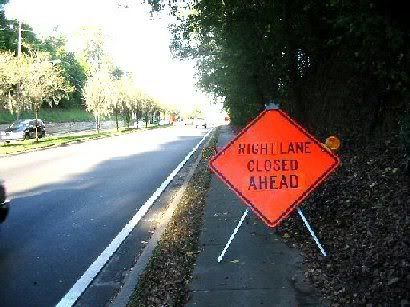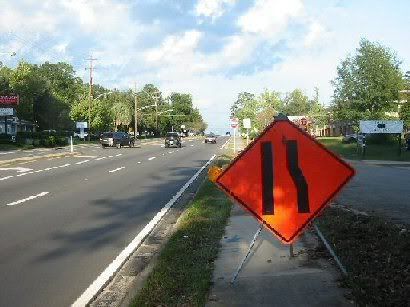Maintenance of Traffic for Pedestrians

Maintenance of Traffic (MOT) can be a complex component of roadway construction and repair. How do you safely do the work, while allowing continued access for roadway users? You have to keep the workers safe, provide information for roadway users, and allow safe passage for them at the same time. Unfortunately, most of maintenance of traffic focuses on cars and bicyclists and pedestrians frequently get left behind.
As I search for references online to provide proper descriptions of the standards, I recall what the City's maintenance of traffic expert described to the BPAC years ago when I was a member. If a sidewalk is closed for more than three hours, it must be closed properly with appropriate signage. If a project causes a sidewalk to be impassable, the project manager is responsible for providing a safe, well-marked, alternate route for pedestrians. At the nearest safe crossing, usually a signalized intersection or one with a marked crosswalk, a sign should be placed that says "Sidewalk closed. Cross here" to direct pedestrians to the sidewalk on the other side of the street.
Thanks to Mary Anne Koos, FDOT District 3 Bike and Ped Coordinator for pointing me to this document that illustrates proper pedestrian Maintenance of Traffic.
Not hard, is it?
Here is what FDOT's Construction Project Administration Manual has to say about it on page 9-1-4:
Bicycle paths through the work zone should be well marked and signed. Bicycle paths should not be directed through pedestrian walkways. Pedestrian paths should be clean of debris, well protected with positive barriers and/or separatedfrom traffic, and be ADA compliant.Pedestrian MOT and Americans with Disabilities Act (ADA) compliance are required parts of the pre-project planning. ADA usually requires three feet (36 inches) of width to get by.
The Manual on Uniform Traffic Control Devices (MUTCD) says this:
6B. FUNDAMENTAL PRINCIPLESSo fundamentally, pedestrians are supposed to see adequate warning, delineation, and channelization. What we see in these pictures on Mahan Drive between Franklin and Magnolia are big honking signs for motorist maintenance of traffic completely blocking the pedestrian pathway.
...
3.Drivers and pedestrians should be guided in a clear and positive manner while approaching and traversing the temporary traffic control zone.
a. Adequate warning, delineation, and channelization by means of proper pavement marking, signs, or use of other devices that are effective under varying conditions of light and weather should be provided where appropriate to assure the driver and pedestrian of positive guidance before approaching and while passing through the work area.
Worse, this is not an isolated incident. The same night I took these pictures, I saw two other sidewalks that were blocked off, under repair, without proper signage in the downtown. One on a city street and one on a state road.
Why is that a problem? Let's say you're walking along a busy road like Mahan. Two lanes each way, 35 mph posted speed limit, 45 mph traffic, five foot wide sidewalk, going uphill. Halfway along the block, your path is completely obstructed. It's impassable. You can't get by. Your choices are to turn around and walk back to the last safe place you could cross or to wade out into the roadway and take your chances.

Being an able-bodied person, I was able to walk around the signs that completely block the sidewalk, but not everyone is able-bodied and further, that's not the point. The pedestrian transportation infrastructure must be treated as a serious and legitimate system equal in quality and importance to the infrastructure we build for motorized traffic. To do otherwise is to make pedestrians second class citizens. You don't see roads suddenly ending or going from paved to unpaved and back again without warning. We would never treat roads that way and we shouldn't treat sidewalks that way.
Not only is this an unnecessary problem, the solution is well-defined, easy and cheap. Put up appropriate signs to direct pedestrian traffic or in the case of the roadway signs blocking the sidewalk, get the right kind of signs that stake into the ground, are made of lightweight fabric, and are high enough above the ground that they don't interfere with pedestrians.
The way things are currently done, this well never happen. Construction crews have no incentive to pay any attention to pedestrian MOT. The penalty for completely ignoring pedestrian MOT is...Nothing. If the worksite is inspected, the inspector may mention to them that they are creating a liability issue, but they don't care. If they are fined, they will pass the cost of the fine back to the client, usually the City or State DOT. If they work is stopped, which is the most serious action the inspector can take on a roadway project, it only increases the cost of the project and creates delays in completion. The City or State gets all the blame for overruns of time or money.
If the city is serious about increasing walkability, they need to get serious about pedestrian maintenance of traffic. They need to be better role models with their own workers, be more consciencious about including pedestrian maintenance of traffic in construction plans, and be more rigorous with their inspections and enforcement.


3 Comments:
Have you noticed they seem to use whatever sign they have handy for a sidewalk closure? The orange symbol sign you photographed literally means right lane ends, merge into left lane. Presumably they don't really expect pedestrians to do that.
Do you have a teen driver? These magnets are great, easy to put on and take off. Perfect for the teenager driving under a permit. The magnets alert other drivers to be patient and aware that a new driver is behind the wheel. A must for every new driver. Visit AutoSafetyMagnets today!
They weren't trying to close the sidewalk, they were closing a lane of the road, but when the work was done for the day, they blocked the sidewalks with their signs. I presume the signs were blocking the sidewalk while the work was going on, as well, since they were far in advance of the apparent work zone.
Post a Comment
<< Home